Lithospheric Structure of the East European Craton at the Transition from Sarmatia to Fennoscandia Interpreted from the TTZ-South Seismic Profile (SE Poland to Ukraine)
Abstract
1. Introduction
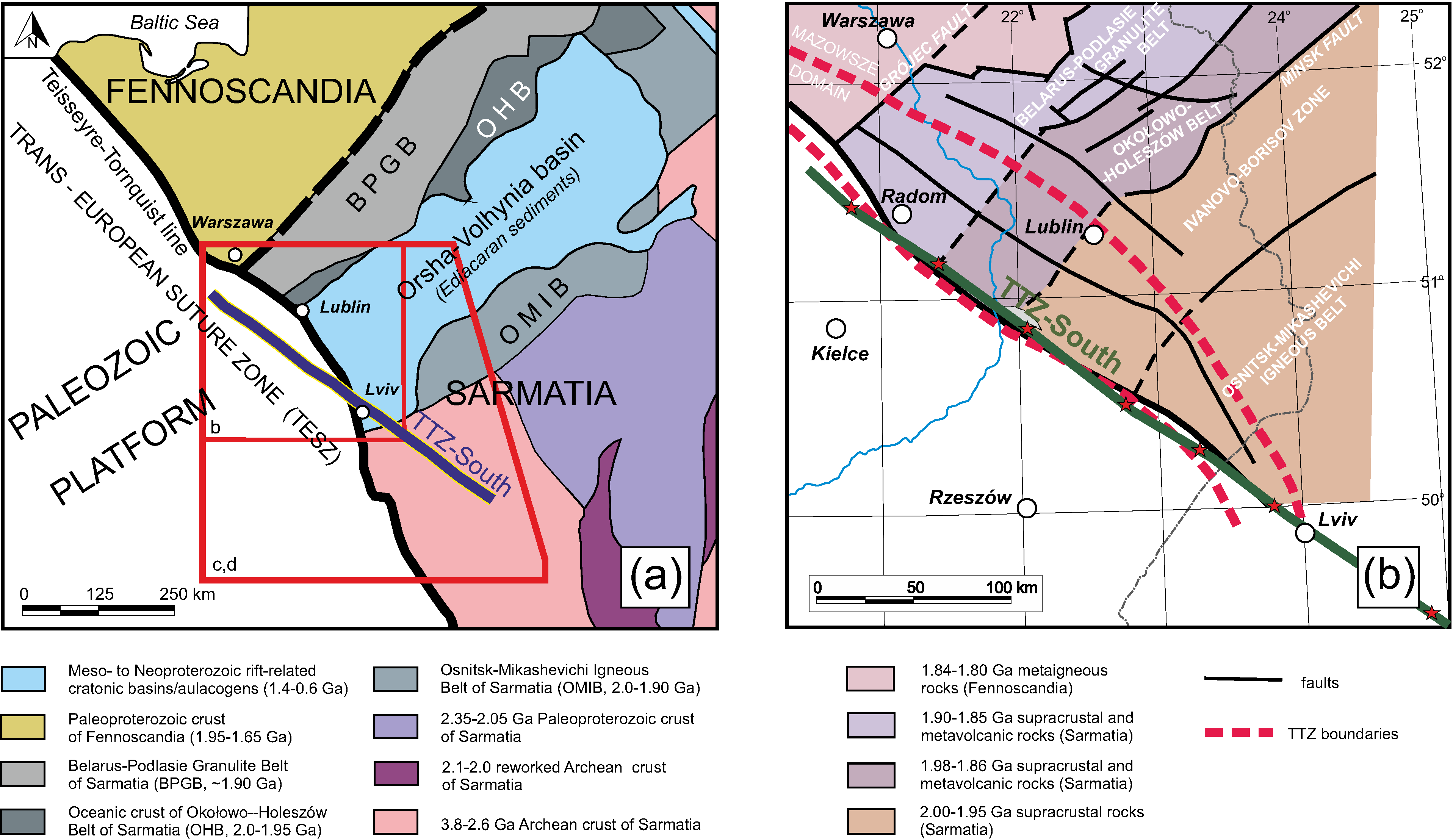
2. Geological and Geophysical Setting
2.1. Uppermost Sedimentary Layer: Phanerozoic to Ediacaran Platform Cover
2.2. Precambrian Crystalline Basement
2.3. Teisseyre-Tornquist Zone (TTZ)
3. Previous Deep Seismic Studies
4. Field Experiment and Seismic Data
4.1. Data Acquisition
4.2. P-Wave Seismic Wavefield
5. Seismic Modelling
5.1. Modelling Methods
5.1.1. Travel-Time Tomography
5.1.2. Trial-and-Error Modelling Strategy
5.2. Crustal Model
5.3. Moho Boundary and Upper Mantle
5.4. Full Waveform Synthetic Sections
5.5. Resolution Analysis
6. Comparison with Previous DSS Profiles in the Area
7. Tectonic Interpretation and Discussion
7.1. Near Surface Geology along the TTZ-South Profile
7.2. Crustal Structure
- Variable arrangement of crystalline crustal layers, changing both laterally and vertically along the transect, with four-layer and three-layer segments in various configurations;
- A tectonic imbrication style with NW-vergent wedge-shaped crustal-scale structural units, likely indicative of a thick-skinned thrust stacking and/or—conversely—of a possible large-scale extensional deformation of SE-polarity;
- Frequent Moho depth changes along the transect, particularly in its central and SE segments which, in general, seem to accommodate the overlying crustal structure complexities;
- Laterally extensive Vp inversion interfaces, where rocks with higher seismic velocities rest on top of those with lower velocities;
- The presence of high-velocity, lens-shaped bodies distributed along the bottom part of the middle crust or near the top of the lower crust;
- A topmost, sedimentary layer of low, ~2 km thickness in the SE in Ukraine, which gradually increases to the NW, up to as much as 8 to 18 km in the Polish part of the TTZ-South profile.
7.2.1. Sarmatia—Fennoscandia Contact
7.2.2. The Sarmatian Domain: Two Major and Two Minor Crustal Units
7.2.3. Extensional Features of Sarmatian Crust
7.2.4. Moho and Uppermost Mantle
7.2.5. Crystalline Basement Changes across the TTZ
7.2.6. Rift Basin of Orsha-Volhynia
7.2.7. High-Velocity Bodies
7.2.8. Seismic Velocity Inversions
8. Conclusions and Regional Implications
Author Contributions
Funding
Data Availability Statement
Acknowledgments
Conflicts of Interest
References
- Pharaoh, T.C. Palaeozoic terranes and their lithospheric boundaries within the Trans-European suture zone (TESZ): A review. Tectonophysics 1999, 314, 17–41. [Google Scholar] [CrossRef]
- Banka, D.; Pharaoh, T.C.; Williamson, J.P. TESZ Project Potential Field Core Group. Potential field imaging of Palaeozoic orogenic structure in northern and central Europe. Tectonophysics 2002, 360, 23–45. [Google Scholar] [CrossRef]
- Winchester, J.A. The PACE TMR Network Team. Palaeozoic amalgamation of Central Europe: New results from recent geological and geophysical investigations. Tectonophysics 2002, 360, 5–21. [Google Scholar] [CrossRef]
- Grad, M. Podolian, Saxonian and Baltic plates—Teisseyre-Tornquist Line and the edge of the East European Craton. Geochemistry 2019, 79, 422–433. [Google Scholar] [CrossRef]
- Grad, M. Teisseyre-Tornquist Line—Evolution of the view on the edge of the East European Craton. Prz. Geof. LXIV 2019, 1–2, 167–183. (In Polish) [Google Scholar] [CrossRef]
- Berthelsen, A. From Precambrian to Variscan Europe. In A Continent Revealed—The European Geotraverse; Blundell, D.J., Freeman, R., Mueller, S., Eds.; Cambridge University Press: New York, NY, USA, 1992; pp. 153–164. [Google Scholar]
- Berthelsen, A. Where different geological philosophies meet: The Trans-European Suture Zone. Publ. Inst. Geophys. Pol. Acad. Sci. 1993, 255, 19–31. [Google Scholar]
- Malinowski, M.; Guterch, A.; Narkiewicz, M.; Probulski, J.; Maksym, A.; Majdański, M.; Środa, P.; Czuba, W.; Gaczyński, E.; Grad, M.; et al. Deep seismic reflection profile in Central Europe reveals complex pattern of Paleozoic and Alpine accretion at the East European Craton margin. Geophys. Res. Lett 2013, 40, 3841–3846. [Google Scholar] [CrossRef]
- Mazur, S.; Mikołajczak, M.; Krzywiec, P.; Malinowski, M.; Buffenmyer, V.; Lewandowski, M. Is the Teisseyre-Tornquist Zone an ancient plate boundary of Baltica? Tectonics 2015, 34, 2465–2477. [Google Scholar] [CrossRef]
- Mazur, S.; Mikołajczak, M.; Krzywiec, P.; Malinowski, M.; Buffenmyer, V.; Lewandowski, M. Reply to Comment by Narkiewicz, M.; Petecki, Z. on “Is the Teisseyre-Tornquist Zone an ancient plate boundary of Baltica?”. Tectonics 2016, 35, 1600–1607. [Google Scholar] [CrossRef][Green Version]
- Mazur, S.; Gągała, Ł.; Kufrasa, M.; Krzywiec, P. Application of two-dimensional gravity models as input parameters to balanced cross-sections across the margin of the East European Craton in SE Poland. J. Struct. Geol. 2018, 116, 223–233. [Google Scholar] [CrossRef]
- Mazur, S.; Krzywiec, P.; Malinowski, M.; Lewandowski, M.; Aleksandrowski, P.; Mikołajczak, M. On the nature of the Teisseyre-Tornquist Zone. Geol. Geophys. Environ. 2018, 44, 17–30. [Google Scholar] [CrossRef]
- Mazur, S.; Aleksandrowski, P.; Gągała, Ł.; Krzywiec, P.; Żaba, J.; Gaidzik, K.; Sikora, R. Late Palaeozoic strike-slip tectonics versus oroclinal bending at the SW outskirts of Baltica: Case of the Variscan belt’s eastern end in Poland. Int. J. Earth Sci. 2020, 109, 1133–1160. [Google Scholar] [CrossRef]
- Krzywiec, P.; Gągała, Ł.; Mazur, S.; Słonka, Ł.; Kufrasa, M.; Malinowski, M.; Pietsch, K.; Golonka, J. Variscan deformation along the Teisseyre-Tornquist Zone in SE Poland: Thick-skinned structural inheritance or thin-skinned thrusting? Tectonophysics 2017, 718, 83–91. [Google Scholar] [CrossRef]
- Krzywiec, P.; Mazur, S.; Gągała, Ł.; Kufrasa, M.; Lewandowski, M.; Malinowski, M.; Buffenmyer, V. Late Carboniferous thin-skinned compressional deformation above the SW edge of the East European craton as revealed by seismic reflection and potential field data—Correlations with the Variscides and the Appalachians. In Linkages and Feedbacks in Orogenic Systems; Law, R.D., Thigpen, J.R., Merschat, A.J., Stowell, H.H., Eds.; The Geological Society of America Memoir 213; Geological Society of America: Boulder, CO, USA, 2017; pp. 353–372. [Google Scholar]
- Mikołajczak, M.; Mazur, S.; Gągała, Ł. Depth-to-basement for the East European Craton and Teisseyre-Tornquist Zone in Poland based on potential field data. Int. J. Earth Sci. 2019, 108, 547–567. [Google Scholar] [CrossRef]
- Mikołajczak, M.; Mazur, S.; Gągała, Ł. Reply to Comment by M. Narkiewicz on “Depth-to-basement for the East European Craton and Teisseyre-Tornquist Zone in Poland based on potential field data, by Mikołajczak et al., International Journal of Earth Sciences (2019) 108, 547–567”. Int. J. Earth Sci. 2019, 108, 1767–1771. [Google Scholar] [CrossRef]
- Narkiewicz, M.; Maksym, A.; Malinowski, M.; Grad, M.; Guterch, A.; Petecki, Z.; Probulski, J.; Janik, T.; Majdański, M.; Środa, P.; et al. Transcurrent nature of the Teisseyre-Tornquist Zone in Central Europe: Results of the POLCRUST-01 deep reflection seismic profile. Int. J. Earth Sci. 2015, 104, 775–796. [Google Scholar] [CrossRef]
- Narkiewicz, M.; Petecki, Z. Comment on “Is the Teisseyre-Tornquist Zone an ancien plate boundary of Baltica?” by Mazur et al. Tectonics 2016, 35, 1595–1599. [Google Scholar] [CrossRef]
- Narkiewicz, M.; Petecki, Z. Teisseyre-Tornquist Zone—Evolving approaches and new data. Przegląd Geol. 2019, 67, 837–848, (In Polish, English abstract). [Google Scholar] [CrossRef]
- Narkiewicz, M. Comment on “Depth-to-basement for the East European Craton and Teisseyre-Tornquist zone in Poland based on potential field data” by Mikołajczak et al. Int. J. Earth Sci. 2019, 108, 1763–1765. [Google Scholar] [CrossRef]
- Janik, T.; Starostenko, V.; Aleksandrowski, P.; Yegorova, T.; Czuba, W.; Środa, P.; Murovskaya, A.; Zajats, K.; Kolomiyets, K.; Lysynchuk, D.; et al. TTZ-South seismic experiment. Geophys. J. 2020, 42, 3–15. [Google Scholar] [CrossRef]
- Bogdanova, S.V.; Gorbatschev, R.; Garetsky, R.G. EUROPE|East European Craton. Reference Module in Earth Systems and Environmental Sciences; Elsevier: Amsterdam, The Netherlands, 2016; pp. 1–18. ISBN 9780124095489. [Google Scholar] [CrossRef]
- Mężyk, M.; Malinowski, M.; Mazur, S. Structure of a diffuse suture between Fennoscandia and Sarmatia in SE Poland based on interpretation of regional reflection seismic profiles supported by unsupervised clustering. Precambrian Res. 2021, 358, 106176. [Google Scholar] [CrossRef]
- Krzemińska, E.; Krzemiński, L.; Petecki, Z.; Wiszniewska, J.; Salwa, S.; Żaba, J.; Gaidzik, K.; Williams, I.S.; Rosowiecka, O.; Taran, L.; et al. Geological Map of Crystalline Basement in the Polish Part of the East European Platform 1:1,000,000; Państwowy Instytut Geologiczny: Warszawa, Poland, 2017. [Google Scholar]
- Mikołajczak, M. Analiza Strukury Podłoża Prowincji Łupków Gazonośnych Centralnej Polski w Oparciu o Dane Grawimetryczne i Magnetyczne. Ph.D. Thesis, Institute of Geological Sciences PAS, Kraków, Poland, 2016; 345p. (In Polish, English abstract). [Google Scholar]
- Grad, M.; Janik, T.; Yliniemi, J.; Guterch, A.; Luosto, U.; Komminaho, K.; Środa, P.; Höing, K.; Makris, J.; Lund, C.-E. Crustal structure of the Mid Polish Trough beneath TTZ seismic profile. Tectonophysics 1999, 314, 145–160. [Google Scholar] [CrossRef]
- Janik, T.; Grad, M.; Guterch, A.; Dadlez, R.; Yliniemi, J.; Tiira, T.; Keller, G.R.; Gaczyński, E.; CELEBRATION 2000 Working Group. Lithospheric structure of the Trans-European Suture Zone along the TTZ & CEL03 seismic profiles (from NW to SE Poland). Tectonophysics 2005, 411, 129–156. [Google Scholar] [CrossRef]
- Bogdanova, S.V. Segments of the East European Craton. In EUROPROBE in Jablonna 1991; Gee, D.G., Beckholmen, M., Eds.; Polish Academy of Sciences and European Science Foundation: Warszawa, Poland, 1993; Volume 255, pp. 33–38. [Google Scholar]
- Bogdanova, S.V.; Pashkevich, I.K.; Gorbatschev, R.; Orlyuk, M.I. Riphean rifting and major Palaeoproterozoic crustal boundaries in the basement of the East-European Craton: Geology and geophysics. Tectonophysics 1996, 268, 1–21. [Google Scholar] [CrossRef]
- Bogdanova, S.; Gorbatschev, R.; Grad, M.; Janik, T.; Guterch, A.; Kozlovskaya, E.; Motuza, G.; Skridlaite, G.; Starostenko, V.; Taran, L.; et al. EUROBRIDGE: New insight into the geodynamic evolution of the East European Craton. Geol. Soc. Lond. Mem. 2006, 32, 599–625. [Google Scholar] [CrossRef]
- Mazur, S.; Scheck-Wenderoth, M.; Krzywiec, P. Different modes of inversion in the German and Polish basins. Int. J. Earth Sci. 2005, 94, 782–798. [Google Scholar] [CrossRef]
- Kley, J.; Voigt, T. Late Cretaceous intraplate thrusting in central Europe: Effect of Africa-Iberia-Europe convergence, not Alpine collision. Geology 2008, 36, 839–842. [Google Scholar] [CrossRef]
- Kley, J. Timing and spatial patterns of Cretaceous and Cenozoic inversion in the Southern Permian Basin. In Mesozoic Resource Potential in the Southern Permian Basin; Kilhams, B., Kukla, P.A., Mazur, S., Mckie, T., Mijnlieff, H.F., Van Ojik, K., Eds.; Geological Society: London, UK, 2018; Volume 469, pp. 1–18. [Google Scholar] [CrossRef]
- Krzywiec, P.; Stachowska, A.; Stypa, A. The only way is up-on Mesozoic uplifts and basin inversion events in SE Poland. In Mesozoic Resource Potential in the Southern Permian Basin; Kilhams, B., Kukla, P.A., Mazur, S., Mckie, T., Mijnlieff, H.F., Van Ojik, K., Eds.; Geological Society: London, UK, 2018; Volume 469, pp. 33–57. [Google Scholar]
- Kruglov, S.S.; Arsiriy, Y.O.; Bobrov, O.B.; Veklich, J.M.; Velikanov, V.Y.; Vishniakov, I.B.; Heychenko, M.V.; Gintov, O.B.; Yentin, V.A.; Znamenskaya, T.O.; et al. Tectonic Map of the Ukraine M 1:1000000. In Explanatory Note, P.1, Min. of Environment Protection, St. Geol. Survey, Ukr.DGRI, Kiev; Kruglov, S., Gursky, S., Eds.; State Geological Service of Ukraine: Kyiv, Ukraine, 2007; 96p. (In Russian) [Google Scholar]
- Buła, Z.; Habryn, R. Precambrian and Palaeozoic basement of the Carpathian Foredeep and the adjacent Outer Carpathians. Ann. Soc. Geol. Pol. 2011, 81, 221–239. [Google Scholar]
- Guterch, A.; Grad, M. Lithospheric structure of the TESZ in Poland based on modern seismic experiments. Geol. Q. 2006, 50, 23–32. [Google Scholar]
- Pożaryski, W. (Ed.) Mapa Geologiczna Polski i Krajów Ościennych Bez Utworów Kenozoicznych 1: 1,000,000; Państwowy Instytut Geologiczny: Warszawa, Poland, 1979. (In Polish) [Google Scholar]
- Pożaryski, W.; Dembowski, Z. (Eds.) Mapa Geologiczna Polski i Krajów Ościennych Bez Utworów Kenozoicznych, Mezozoicznych i Permskich, 1:1 000 000; Państwowy Instytut Geologiczny: Warszawa, Poland, 1984. (In Polish) [Google Scholar]
- Galetsky, L.S. (Ed.) An Atlas of the Geology and Mineral Deposits of Ukraine (Scale 1:5,000,000); University of Toronto Press: Toronto, ON, Canada, 2007; 168p. [Google Scholar]
- Zayats, K. Hlubinna Budova Nadr Zakhidnoho Rehionu Ukrainy na Osnovi Seysmichnykh Doslidshzen’ i Napriamky Poshukovykh Robit na Naftu ta Haz (The Structure of Minerals of the Western Region of Ukraine on the Basis of Seismic Studies and the Directions for Oil and Gas Exploration Studies); Monograph, USGEI: Lviv, Ukraine, 2013; Volume 2015, 80p. (In Ukrainian) [Google Scholar]
- Bogdanova, S.; Gorbatschev, R.; Skridlaite, G.; Soesoo, A.; Taran, L.; Kurlovich, D. Trans-Baltic Palaeoproterozoic correlations towards the reconstruction of supercontinent Columbia/Nuna. Precambrian Res. 2015, 259, 5–33. [Google Scholar] [CrossRef]
- Pożaryski, W. Central Europe’s Caledonides as a strike-slip orogen composed of terranes. Przegląd Geol. 1990, 38, 1–9, (In Polish, English abstract). [Google Scholar]
- Belka, Z.; Valverde-Vaquero, P.; Dörr, W.; Ahrendt, H.; Wemmer, K.; Franke, W.; Schäfer, J. Accretion of first Gondwana-derived terranes at the margin of Baltica. Geol. Soc. Lond. Spec. Publ. 2002, 201, 19–36. [Google Scholar] [CrossRef]
- Dadlez, R.; Grad, M.; Guterch, A. Crustal structure below the Polish Basin: Is it composed of proximal terranes derived from Baltica? Tectonophysics 2005, 411, 111–128. [Google Scholar] [CrossRef]
- Nawrocki, J.; Poprawa, P. Development of Trans-European Suture Zone in Poland: From Ediacaran rifting to early Palaeozoic accretion. Geol. Q. 2006, 50, 59–76. [Google Scholar]
- Narkiewicz, M.; Grad, M.; Guterch, A.; Janik, T. Crustal seismic velocity structure of southern Poland: Preserved memory of a pre-Devonian terrane accretion at the East European Platform margin. Geol. Mag. 2011, 148, 191–210. [Google Scholar] [CrossRef]
- Poprawa, P. Geological setting and Ediacaran–Palaeozoic evolution of the western slope of the East European Craton and adjacent regions. Ann. Soc. Geol. Pol. 2019, 89, 347–380. [Google Scholar] [CrossRef]
- Tomaszczyk, M.; Jarosiński, M. The Kock Fault Zone as an indicator of tectonic stress regime changes at the margin of the EastEuropean Craton (Poland). Geol. Q. 2017, 61, 908–925. [Google Scholar]
- Mizerski, W. Geotectonic evolution of the Holy Cross Mts in Central Europe. Biul. Państwowego Inst. Geol. 1995, 372, 1–47. [Google Scholar]
- Gągała, Ł. Pre-Ordovician polyphase tectonics of the Cambrian sequences in the Kielce Unit, Holy Cross Mts. (CentralPoland). Geol. Q. 2005, 49, 53–66. [Google Scholar]
- Belka, Z.; Ahrendt, H.; Franke, W.; Wemmer, K. The Baltica–Gondwana suture in central Europe: Evidence from K-Ar ages of detrital muscovites and biogeographical data. Geol. Soc. Lond. Spec. Publ. 2000, 179, 87–102. [Google Scholar] [CrossRef]
- Żelaźniewicz, A.; Aleksandrowski, P.; Buła, Z.; Karnkowski, P.H.; Konon, A.; Oszczypko, N.; Ślączka, A.; Żaba, J.; Żytko, K. Regionalizacja Tektoniczna Polski (Geological Division of Poland); Commitee of Geological Sciences, Polish Academy of Sciences: Wrocław, Poland, 2011; 60p. (In Polish) [Google Scholar]
- Żelaźniewicz, A.; Buła, Z.; Fanning, M.; Seghedi, A.; Żaba, J. More evidence on Neoproterozoic terranes in southern Poland and southeastern Romania. Geol. Q. 2009, 53, 93–124. [Google Scholar]
- Aleksandrowski, P.; Mazur, S. On the new tectonic solutions in the Geological Atlas of Poland. Przegląd Geol. 2017, 65, 1499–1510, (In Polish, English abstract). [Google Scholar]
- Malinowski, M.; Guterch, A.; Narkiewicz, M.; Petecki, Z.; Janik., T.; Środa, P.; Maksym, A.; Probulski, J.; Grad, M.; Czuba, W.; et al. Geophysical constraints on the crustal structure of the East European Platform margin and its foreland based on the POLCRUST-01 deep reflection seismic profile. Tectonophysics 2015, 653, 109–126. [Google Scholar] [CrossRef]
- Bogdanova, S.V.; Bingen, B.; Gorbatschev, R.; Kheraskova, T.N.; Kozlov, V.I.; Puchkov, V.N.; Volozh, Y.A. The East European Craton (Baltica) before and during the assembly of Rodinia. Precambrian Res. 2008, 160, 23–45. [Google Scholar] [CrossRef]
- Poprawa, P.; Pacześna, J. Late Neoproterozoic to Early Palaeozoic developmentof a rift at the Lublin-Podlasie slope of the East European Craton-analysis of subsidence and facies record (eastern Poland). Prz. Geol. 2002, 50, 49–63. [Google Scholar]
- Pacześna, J.; Poprawa, P. Eustatic versus tectonic control on the development of Neoproterozoic and Cambrian stratigraphic sequences of the Lublin-Podlasie Basin (SW margin of Baltica). Geosci. J. 2005, 9, 117–127. [Google Scholar] [CrossRef]
- Białowolska, A.; Bakun-Czubarow, N.; Fedoryshyn, Y. Neoproterozoic flood basalts of the upper beds of the Volhynian Series (East European Craton). Geol. Q. 2002, 46, 37–58. [Google Scholar]
- Emetz, A.; Piestrzyński, A.; Zagnitko, V. Geological framework of the Volhyn copper fields with a review of the Volhyn flood basalt province (western margin of the East-European Craton). Ann. Soc. Geol. Pol. 2004, 74, 257–265. [Google Scholar]
- Krzemińska, E. The outline of geochemical features of the Late Neoproterozoic volcanic activity in the Lublin-Podlasie basin, eastern Poland. Mineral. Soc. Pol. Spec. Pap. 2005, 26, 47–51. [Google Scholar]
- Compston, W.; Sambridge, M.S.; Reinfrank, R.F.; Moczydłowska, M.; Vidal, G.; Claesson, S. Numerical ages of volcanic rocks and the earliest faunal zone within the Late Precambrian of east Poland. J. Geol. Soc. Lond. 1995, 152, 111–128. [Google Scholar] [CrossRef]
- Velikanov, V.; Korenchuk, L. Phases of magmatism and their relation to the sediment deposition in the Late Precambrian (Riphean-Vendian) of the Volhyn-Podolia. Geol. Zhurnal 1997, 1-2, 124–131. [Google Scholar]
- Poprawa, P. Neoproterozoic break-up of the supercontinent Rodinia/Pannotia recorded by development of sedimentary basins at the western slope of Baltica. Pr. Państwowego Inst. Geol. 2006, 186, 165–188, (In Polish, English summary). [Google Scholar]
- Shumlyanskyy, L.; Nosova, A.; Billström, K.; Söderlund, U.; Andréasson, P.-G.; Kuzmenkova, O. The U-Pb zircon and baddeleyite ages of the Neoproterozoic Volyn Large Igneous Province: Implication for the age of the magmatism and the nature of a crustal contaminant. GFF 2016, 13, 17–30. [Google Scholar] [CrossRef]
- Poprawa, P.; Krzemińska, E.; Pacześna, J.; Amstrong, R. Geochronology of the Volyn volcanic complex at the western slope of the East European Craton—Relevance to the Neoproterozoic rifting and the break-up of Rodinia/Pannotia. Precambrian Res. 2020, 346, 105817. [Google Scholar] [CrossRef]
- Żelaźniewicz, A.; Buła, Z.; Jachowicz, M.; Żaba, J. The crystalline basement SW of the Trans-European Suture Zone in Poland: Neoproterozoic (Cadomian) Orogen. Terra Nostra 1997, 97, 167–171. [Google Scholar]
- Żelaźniewicz, A. Rodinian-Baltican link of the Neoproterozoic orogen in southern Poland. Acta Univ. Carolinae Geol. 1998, 42, 509–515. [Google Scholar]
- Malinowski, M.; Żelaźniewicz, A.; Grad, M.; Guterch, A.; Janik, T.; CELEBRATION 2000 Working Group. Seismic and geological structure of the crust in the transition from Baltica to Palaeozoic Europe in southeast Poland—CELEBRATION 2000 experiment, profile CEL02. Tectonophysics 2005, 401, 55–77. [Google Scholar] [CrossRef]
- Pacześna, J. Ewolucja późnoneoproterozoicznych-wczesnokambryjskich ryftowych depocentrów i facji w lubelsko-podlaskim basenie sedymentacyjnym. Pr. Państwowego Inst. Geol. 2006, 186, 9–38. [Google Scholar]
- Pacześna, J. The evolution of late Ediacaran riverine-estuarine system in the Lublin-Podlasie slope of the East European Craton, southeastern Poland. Pol. Geol. Inst. Spec. Pap. 2010, 27, 1–96. [Google Scholar]
- Smit, J.; Van Wees, J.D.; Cloetingh, S. The Thor suture zone: From subduction to intraplate basin setting. Geology 2016, 44, 707–710. [Google Scholar] [CrossRef]
- Grad, M.; Guterch, A.; Mazur, S. Seismic refraction evidence for continental structure in the central part of the Trans-European Suture Zone in Poland. Geol. Soc. Lond. Spec. Publ. 2002, 201, 295–309. [Google Scholar] [CrossRef]
- Grad, M.; Keller, G.R.; Thybo, H.; Guterch, A. POLONAISE Working Group. Lower lithospheric structure beneath the Trans-European Suture Zone from POLONAISE ’97 seismic profiles. Tectonophysics 2002, 360, 153–168. [Google Scholar] [CrossRef]
- Perchuć, E. Structure of the Earth’s crust in southeastern Poland. Publ. Inst. Geophys. Pol. Acad. Sci. 1984, 160, 77–86. [Google Scholar]
- Janik, T.; Grad, M.; Guterch, A.; CELEBRATION 2000 Working Group. Seismic structure of the lithosphere between the East European Craton and the Carpathians from the net of CELEBRATION 2000 profiles in SE Poland. Geol. Q. 2009, 53, 141–158. [Google Scholar]
- Środa, P.; Czuba, W.; Grad, M.; Guterch, A.; Tokarski, A.; Janik, T.; Rauch, M.; Keller, G.R.; Hegedűs, E.; Vozár, J.; et al. Crustal structure of the Western Carpathians from CELEBRATION 2000 profiles CEL01 and CEL04: Seismic models and geological implication. Geophys. J. Int. 2006, 167, 737–760. [Google Scholar] [CrossRef]
- Wybraniec, S.; Majorowicz, J. Kompleksowe modelowanie pól potencjalnych (grawimetria, magnetyka, geotermia) wzdłuż profili sejsmicznych CELEBRATION 2000. In Kompleksowa Interpretacja Anomalii Pól Potencjalnych Wzdłuż Wszystkich Profili Głębokich Badań Refrakcyjnych Zrealizowanych na Całym Obszarze CELEBRATION 2000, Stow. Dla Głębokich Badań Geol. (ADGiP), Rap. Końcowy Dla Minist. Środowiska; Guterch, A., Grad, M., Eds.; ADGiP: Warszawa, Poland, 2008. rozdz. IV.7. (In Polish)(In Polish) [Google Scholar]
- Teisseyre, W. Całokształt płyty paleozoicznej Podola galicyjskiego. Rzecz o przyszłych wierceniach głębokich na Podolu opolskiem. Kosmos 1893, 18, 319–336. (In Polish) [Google Scholar]
- Teisseyre, W. Der paläozoische Horst von Podolien und die ihn umgehenden Senkungsfelder. In Beiträge zur Paläontologie und Geologie Österreich-Ungarns und des Orients; W. Braumüller: Vienna, Austria, 1903; pp. 101–126. [Google Scholar]
- Tornquist, A. Die Feststellung des Südwesttrendes des baltisch–russischen Schildes und die geotektonische Zugehöringheit der ost-preussischen Scholle. Schr. Der Phys. Ökonomischen Ges. Zu Königsberg 1908, 49, 1–12. [Google Scholar]
- Tornquist, A. Geologie Von Ostpreussen; Gebrüder Borntraeger: Berlin, Germany, 1910; 231p. [Google Scholar]
- Królikowski, C.; Petecki, Z. Gravimetric Atlas of Poland; Polish Geological Institute: Warszawa, Poland, 1995. [Google Scholar]
- Królikowski, C.; Wybraniec, S. Gravity and magnetic maps of Poland—Historical background and modern presentation. Publ. Inst. Geophys. Pol. Acad. Sci. 1996, M18, 87–92. [Google Scholar]
- Grabowska, T.; Bojdys, G.; Dolnicki, J. Three-dimensional density model of the Earth’s crust and the upper mantle for the area of Poland. J. Geodyn. 1998, 25, 5–34. [Google Scholar] [CrossRef]
- Grabowska, T.; Bojdys, G. The border of the East-European Craton in south-eastern Poland based on gravity and magnetic data. Terra Nova 2001, 13, 92–98. [Google Scholar] [CrossRef]
- Wybraniec, S. Transformations and visualization of potential field data. In Polish Geological Institute Special Papers, 1; Polish Geological Institute: Warszawa, Poland, 1999; pp. 1–59. [Google Scholar]
- Majorowicz, J.A.; Čermák, V.; Šafanda, J.; Krzywiec, P.; Wróblewska, M.; Guterch, A.; Grad, M. Heat flow across the Trans-European Suture Zone in the area of the POLONAISE’97 seismic experiment. Phys. Chem. Earth 2003, 28, 375–391. [Google Scholar] [CrossRef]
- Majorowicz, J.; Wybraniec, S. Variscan geotherms in the context of the new heat flow map of Central Europe corrected for the paleoclimatic glacial-hiolocene change. Schiftenreihe Der Dtsch. Gesselschaft Für Geowiss. 2009, 63, 168. [Google Scholar]
- Majorowicz, J.; Wybraniec, S. New terrestrial heat flow map of Europe after regional paleoclimatic correction application. Int. J. Earth Sci. 2011, 100, 881–887. [Google Scholar] [CrossRef]
- Grabowska, T.; Bojdys, G.; Bielik, M.; Csicsay, K. Density and magnetic models of the lithosphere along CELEBRATION 2000 profile CEL 01. Acta Geophys. Pol. 2011, 59, 526–560. [Google Scholar] [CrossRef]
- Narkiewicz, M.; Petecki, Z. Basement structure of the Paleozoic Platform in Poland. Geol. Q. 2017, 6, 502–520. [Google Scholar] [CrossRef]
- Grabowska, T.; Bojdys, G.; Petecki, Z. Application of the magnetic anomalies for identification of structure of the crystalline basement of southeastern Poland. Biul. Państwowego Inst. Geol. 2017, 470, 17–48, (In Polish, English summary). [Google Scholar] [CrossRef]
- Berthelsen, A. The Tornquist Zone northwest of Carpathians: An intraplate pseudosuture. Geol. För. Stockh. Förh. 1998, 120, 223–230. [Google Scholar] [CrossRef]
- Grad, M.; Guterch, A.; Keller, G.R.; Janik, T.; Hegedűs, E.; Vozár, J.; Ślączka, A.; Tiira, T.; Yliniemi, J. Lithospheric structure beneath trans-Carpathian transect from Precambrian platform to Pannonian basin CELEBRATION 2000 seismic profile CEL05. J. Geophys. Res. 2006, 111, B03301. [Google Scholar] [CrossRef]
- Grad, M.; Janik, T.; Guterch, A.; Środa, P.; Czuba, W.; EUROBRIDGE’94–97, POLONAISE’97 & CELEBRATION 2000 Seismic Working Groups. Lithospheric structure of the western part of the East European Craton investigated by deep seismic profiles. Geol. Q. 2006, 50, 9–22. [Google Scholar]
- Guterch, A.; Grad, M.; Keller, G.R.; Brückl, E. Crustal and Lithospheric Structures Between the Alps and East European Craton from Long-Range Controlled Source Seismic Experiments. In Treatise on Geophysics, 2nd ed.; Schubert, G., Romanowicz, B., Dziewonski, A., Eds.; Deep Earth Seismology; Elsevier: Amsterdam, The Netherlands; Oxford, UK, 2015; Volume 1, pp. 557–586. [Google Scholar] [CrossRef]
- Janik, T.; Grad, M.; Guterch, A.; Vozár, J.; Bielik, M.; Vozárova, A.; Hegedűs, E.; Kovács, C.S.; Kovács, I.; Keller, G.R.; et al. Crustal structure of the Western Carpathians and Pannonian Basin: Seismic models from CELEBRATION 2000 data and geological implications. J. Geodyn. 2011, 52, 97–113. [Google Scholar] [CrossRef]
- Środa, P. The bright spot in the West Carpathian upper mantle: A trace of the Tertiary plate collision—And a caveat for a seismologist. Geophys. J. Int. 2010, 182, 1–10. [Google Scholar] [CrossRef]
- Sollogub, V.B.; Chekunov, A.V.; Kaluznaya, L.T. Lithosphere structure along the geotraverse II. In Lithosphere of Central and East Europe. Geotraverse I, II, V; Naukova Dumka: Kiev, Ukraine, 1988; p. 63. (In Russian) [Google Scholar]
- Starostenko, V.; Janik, T.; Kolomiyets, K.; Czuba, W.; Środa, P.; Grad, M.; Kovács, I.; Stephenson, R.; Lysynchuk, D.; Thybo, H.; et al. Seismic velocity model of the crust and upper mantle along profile PANCAKE across the Carpathians between the Pannonian Basin and the East European Craton. Tectonophysics 2013, 608, 1049–1072. [Google Scholar] [CrossRef]
- Starostenko, V.; Janik, T.; Mocanu, V.; Stephenson, R.; Yegorova, T.; Amashukeli, T.; Czuba, W.; Środa, P.; Murovskaya, A.; Kolomiyets, K.; et al. RomUkrSeis: Seismic model of the crust and upper mantle across the Eastern Carpathians—From the Apuseni Mountains to the Ukrainian Shield. Tectonophysics 2020, 794, 228620. [Google Scholar] [CrossRef]
- Hole, J.A. Nonlinear high-resolution three-dimensional seismic travel time tomography. J. Geophys. Res. 1992, 97, 6553–6562. [Google Scholar] [CrossRef]
- Červený, P.; Pšenčík, I. SEIS83—Seismic Program Package; University Karlova: Prague, Czech Republic, 1983. [Google Scholar]
- Červený, V.; Pšenčík, I. SEIS83—Numerical modelling of seismic wave fields in 2-D laterally varying layered structures by the ray method. In Documentation of Earthquake Algorithms; Engdal, E.R., Ed.; Rep. SE-35; World Data Center (A) for Solid Earth Geophysicists: Boulder, CO, USA, 1984; pp. 36–40. [Google Scholar]
- Komminaho, K. Software Manual for Programs MODEL and XRAYS: A Graphical Interface for SEIS83 Program Package; University of Oulu: Oulu, Finland, 1998; p. 31. [Google Scholar]
- Zelt, C.A. Software Package ZPLOT; Bullard Laboratories, University of Cambridge: Cambridge, UK, 1994. [Google Scholar]
- Kostyukevich, A.S.; Starostenko, V.I.; Stephenson, R.A. The full-wave images of the models of the deep lithosphere structures constructed according to DSS and CDP data interpretation. Geophys. J. 2000, 22, 96–98. [Google Scholar]
- Kotański, Z. (Ed.) Geological Atlas of Poland—Geological Maps of Horizontal Section 1:750,000; Państwowy Instytut Geologiczny: Warszawa, Poland, 1997. (In Polish) [Google Scholar]
- Środa, P. Seismic anisotropy of the upper crust in southeastern Poland—Effect of the compressional deformation at the EEC margin: Results of CELEBRATION 2000 seismic data inversion. Geophys. Res. Lett. 2006, 33, L22302. [Google Scholar] [CrossRef]
- Środa, P. Crustal Structure, Seismic Anisotropy and Deformations of the Ediacaran/Cambrian of the Małopolska Block in SE Poland Based on Data from Two Seismic Wide-Angle Experiments. Pure Appl. Geophys. 2017, 174, 1711–1728. [Google Scholar] [CrossRef][Green Version]
- Starostenko, V.; Janik, T.; Yegorova, T.; Czuba, W.; Środa, P.; Lysynchuk, D.; Aizberg, R.; Garetsky, R.; Karataev, G.; Gribik, Y.; et al. Lithospheric structure along wide-angle seismic profile GEORIFT 2013 in Pripyat-Dnieper-Donets Basin (Belarus and Ukraine). Geophys. J. Int. 2018, 212, 1932–1962. [Google Scholar] [CrossRef]
- Puzyrev, N.N. Time Fields of Reflected Waves and the Method of Effective Parameters; Nauka: Novosibirsk, Russia, 1979; 294p. (In Russian) [Google Scholar]
- Kolomiyets, A.V.; Kharchenko, A.V. Tuning parallel computations for low-bandwidth network. Comput. Math. 2008, 1, 63–69. (In Russian) [Google Scholar]
- Janik, T.; Yliniemi, J.; Grad, M.; Thybo, H.; Tiira, T.; POLONAISE P2 Working Group. Crustal structure across the TESZ along POLONAISE’97 seismic profile P2 in NW Poland. Tectonophysics 2002, 360, 129–152. [Google Scholar] [CrossRef]
- Grad, M.; Jensen, S.L.; Keller, G.R.; Guterch, A.; Thybo, H.; Janik, T.; Tiira, T.; Yliniemi, J.; Luosto, U.; Motuza, G.; et al. Crustal Structure of the Trans-European suture zone region along POLONAISE’97 seismic profile P4. J. Geophys. Res. 2003, 108, 2541. [Google Scholar] [CrossRef]
- Grad, M.; Guterch, A.; Mazur, S.; Keller, G.R.; Špičák, A.; Hrubcová, P.; Geissler, W.H. Lithospheric structure of the Bohemian Massif and adjacent Variscan belt in central Europe based on profile S01 from the SUDETES 2003 experiment. J. Geophys. Res. 2008, 113, B10304. [Google Scholar] [CrossRef]
- Janik, T.; Kozlovskaya, E.; Heikkinen, P.; Yliniemi, J.; Silvennoinen, H. Evidence for preservation of crustal root beneath the Proterozoic Lapland-Kola orogen in the northern Fennoscandian shield derived from P-and S-wave velocity models of POLAR and HUKKA wide-angle reflection and refraction profiles and FIRE4 reflection transect. J. Geophys. Res. 2009, 114, B06308. [Google Scholar] [CrossRef]
- Guterch, A. Structure and physical properties of the Earth’s crust in Poland in the light of new data of DSS. Publ. Inst. Geophys. Pol. Acad. Sci. 1977, A-4, 347–357. [Google Scholar]
- Guterch, A.; Grad, M.; Materzok, R.; Perchuć, E. Deep structure of the Earth’s crust in the contact zone of the Palaeozoic and Precambrian platforms in Poland (Tornquist-Teisseyre zone). Tectonophysics 1986, 128, 251–279. [Google Scholar] [CrossRef]
- Guterch, A.; Grad, M.; Materzok, R.; Perchuć, E.; Janik, T.; Gaczyński, E.; Doan, T.T.; Białek, T.; Gadomski, D.; Młynarski, S.; et al. Structure of the lower crust of the Paleozoic Platform in Poland from seismic wide-angle and near-vertical reflection surveys. Publ. Inst. Geophys. Pol. Acad. Sci. 1991, A-19, 41–62. [Google Scholar]
- Egorkin, A.V. Analysis of the accuracy determination of velocity cross-section in the Earth’s crust from travel time of reflected waves. Izv. Akad. Nauk SSSR. Fiz. Zemli 1966, 9, 72–81. (In Russian) [Google Scholar]
- Grad, M. Determination of mean velocities and depths of boundaries in the Earth’s crust from reflected waves. Acta Geophys. Pol. 1983, 31, 231–241. [Google Scholar]
- Narkiewicz, M. Development and inversion of Devonian and Carboniferous basins in the eastern part of the Variscan foreland (Poland). Geol. Q. 2007, 51, 231–256. [Google Scholar]
- Mazur, S.; Aleksandrowsk, P.; Turniak, K.; Krzemiński, L.; Mastalerz, K.; Górecka-Nowak, A.; Kurowski, L.; Krzywiec, P.; Żelaźniewicz, A.; Fanning, M.C. Uplift and late orogenic deformation of the Central European Variscan belt as revealed by sediment provenance and structural record in the Carboniferous foreland basin of western Poland. Int. J. Earth Sci. 2010, 99, 47–64. [Google Scholar] [CrossRef]
- McClay, K.R. Glossary of thrust tectonics terms. In Thrust Tectonics; McClay, K.R., Ed.; Chapman & Hall: London, UK, 1992; pp. 419–433. [Google Scholar]
- Boyer, S.E.; Elliott, D. Thrust systems. Am. Assoc. Pet. Geol. Bull. 1982, 66, 1196–1230. [Google Scholar]
- Butler, R.; Bond, C. Thrust systems and contractional tectonics. In Regional Geology and Tectonics, 2nd ed.; Volume 1: Principles of Geologic Analysis; Elsevier: Amsterdam, The Netherlands, 2020; pp. 149–167. [Google Scholar] [CrossRef]
- Starostenko, V.; Janik, T.; Lysynchuk, D.; Środa, P.; Czuba, W.; Kolomiyets, K.; Aleksandrowski, P.; Gintov, O.; Omelchenko, V.; Komminaho, K.; et al. Lithosphere-scale buckling of the east European Craton in southern Ukraine: DOBRE-4 deep seismic profile. Geophys. J. Int. 2013, 195, 740–766. [Google Scholar] [CrossRef]
- Crittenden, M.D.; Coney, P.J.; Davis, G.H. (Eds.) Cordilleran Metamorphic Core Complexes; Geological Society of America: Boulder, CO, USA, 1980; Volume 153, 490p. [Google Scholar]
- Lister, G.S.; Davis, G.A. The origin of metamorphic core complexes and detachment faults formed during Tertiary continental extension in the northern Colorado river region, U.S.A. J. Struct. Geol. 1989, 11, 65–94. [Google Scholar] [CrossRef]
- Scott, R.J.; Lister, G.S. Detachment faults: Evidence for a low-angle origin. Geology 1992, 20, 833–836. [Google Scholar] [CrossRef]
- Wheeler, J.; Butler, R.W.H. Criteria for identyfying structures related to true crustal extension in orogens. J. Struct. Geol. 1994, 16, 1023–1027. [Google Scholar] [CrossRef]
- Narkiewicz, M. Geological History of Poland; Wydawnictwa Uniwersytetu Warszawskiego: Warszawa, Poland, 2020; 279p. (In Polish) [Google Scholar]
- Abbott, D.H.; Mooney, W.D.; VanTongeren, J.A. The character of the Moho and lower crust within Archean cratons and the tectonic implications. Tectonophysics 2013, 609, 690–705. [Google Scholar] [CrossRef]
- Coward, M. Inversion tectonics. In Continental Deformation; Hancock, P.L., Ed.; Pergamon Press: Oxford, UK, 1994; pp. 289–304. [Google Scholar]
- Mitra, S. Duplex structures and imbricate thrust systems: Geometry, structural position and hydrocarbon potential. Am. Assoc. Petrol. Geol. Bull. 1986, 70, 1087–1112. [Google Scholar]
- Maystrenko, Y.; Scheck-Wenderoth, M. Density contrasts in the upper mantle and lower crust across the continent—Ocean transition: Constraints from 3-D gravity modelling at the Norwegian margin. Geophys. J. Int. 2009, 179, 536–548. [Google Scholar] [CrossRef]
- Mjelde, R.; Faleide, J.I.; Breivik, A.J.; Raum, T. Lower crustal composition and crustal lineaments on the Voring Margin, NE Atlantic: A review. Tectonophysics 2009, 472, 183–193. [Google Scholar] [CrossRef]
- Mjelde, R.; Goncharov, A.; Müller, R.D. The Moho: Boundary above upper mantle peridotites or lower crustal eclogites? A global review and new interpretations for passive margins. Tectonophysics 2013, 609, 636–650. [Google Scholar] [CrossRef]
- Reynisson, R.F.; Ebbing, J.; Lundin, E.; Osmundsen, P.T. Properties and Distribution of Lower Crustal Bodies on the Mid-Norwegian Margin; Petroleum Geology Conference Series 7; Geological Society of London: London, UK, 2010; pp. 843–854. [Google Scholar]
- Becker, K.; Franke, D.; Trumbull, R.; Schnabel, M.; Heyde, I.; Schreckenberger, B.; Koopmann, H.; Bauer, K.; Jokat, W.; Krawczyk, C. Asymmetry of high-velocity lower crust on the South Atlantic rifted margins and implications for the interplay of magmatism and tectonics in continental breakup. Solid Earth 2014, 5, 1011–1026. [Google Scholar] [CrossRef]
- Butler, R.W.H. Thrust sequences. J. Geol. Soc. Lond. 1987, 144, 619–634. [Google Scholar] [CrossRef]
- Żelaźniewicz, A.; Oberc-Dziedzic, T.; Slama, J. Baltica and the Cadomian orogen in the Ediacaran–Cambrian: A perspective from SE Poland. Int. J. Earth Sci. 2020, 109, 1503–1528. [Google Scholar] [CrossRef]
- Wessel, P.; Smith, W.H.F. New version of the Generic Mapping Tools released. Eos Trans. Am. Geophys. Union 1995, 76, 329. [Google Scholar] [CrossRef]
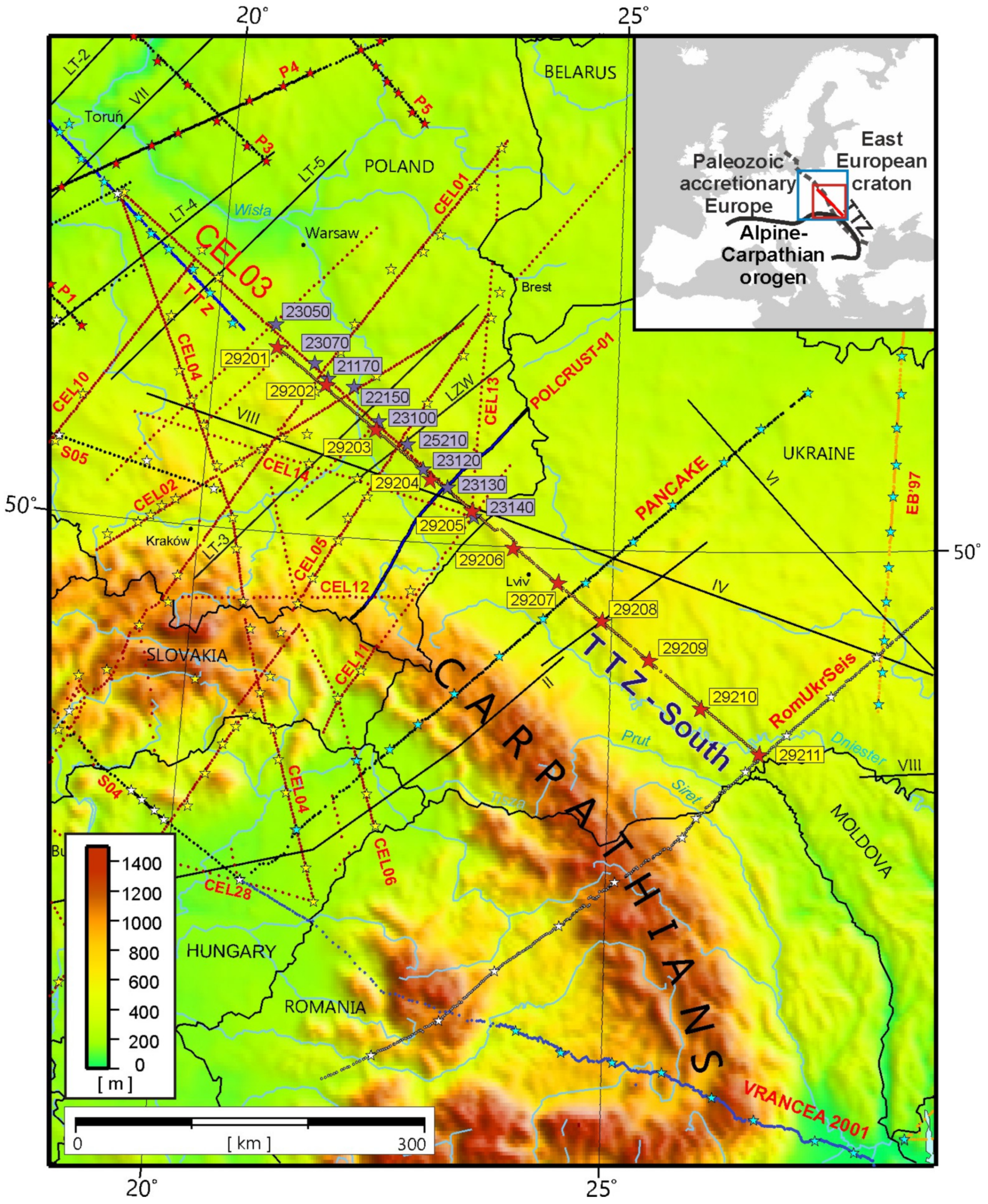
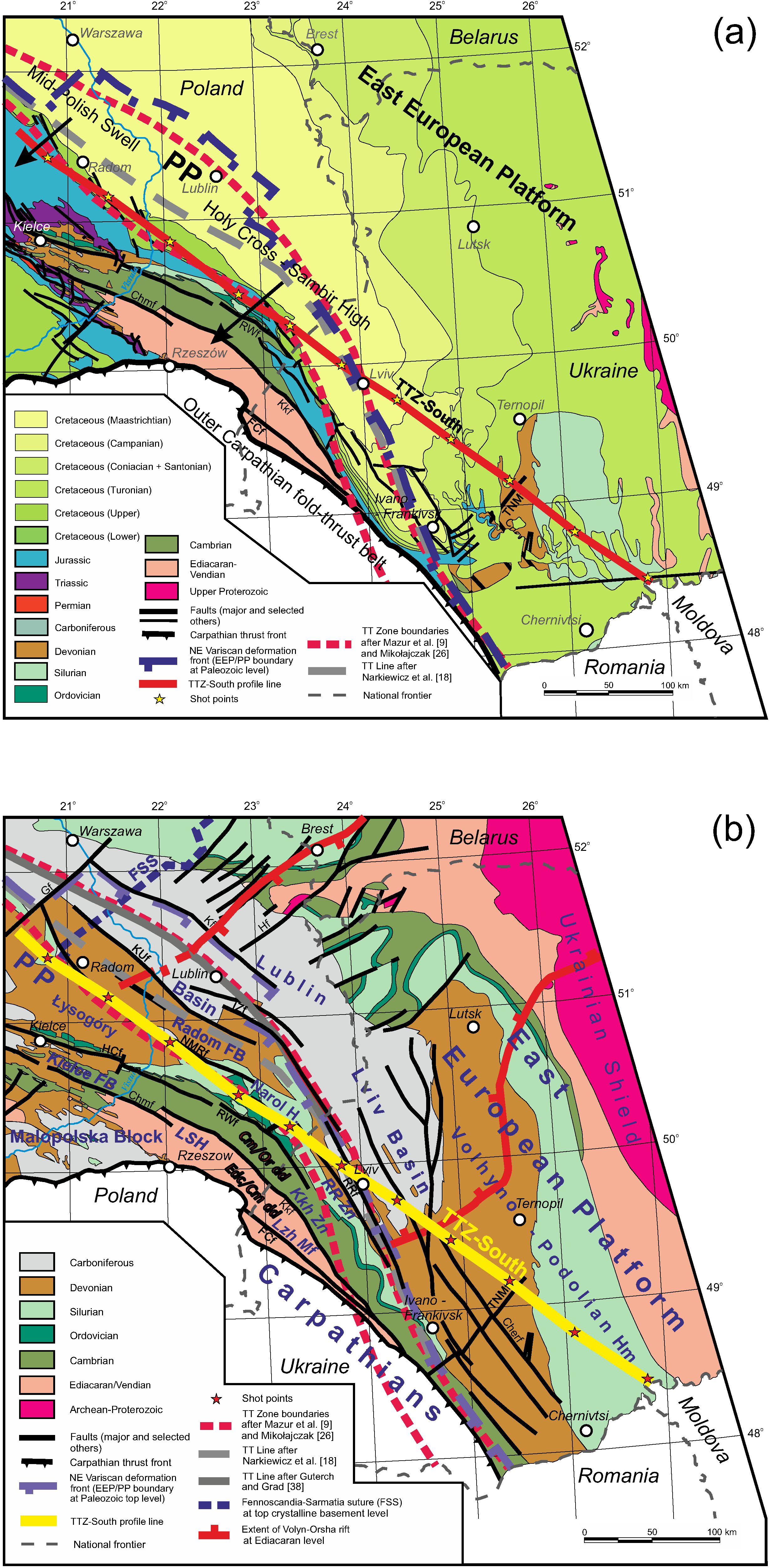

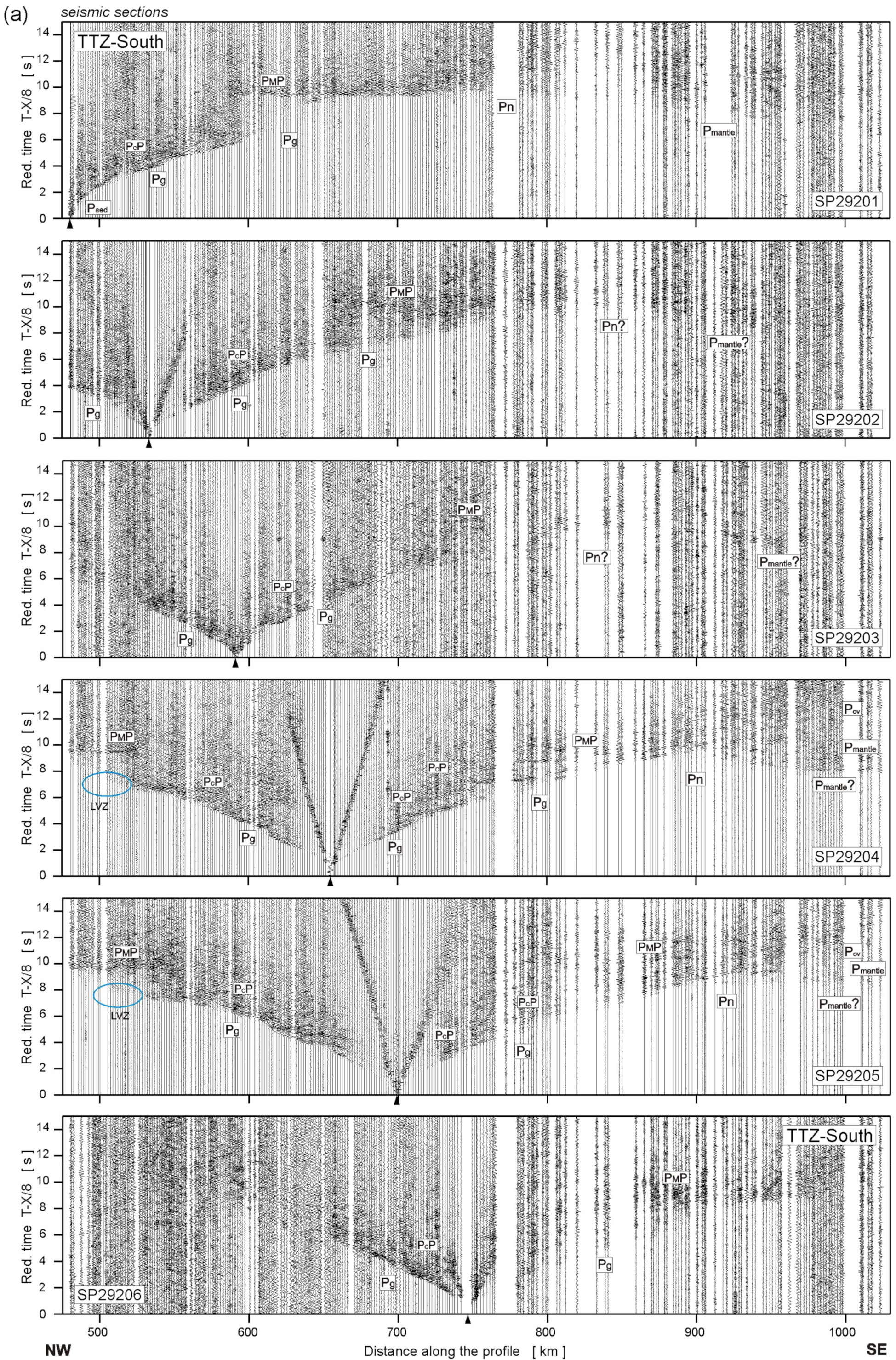

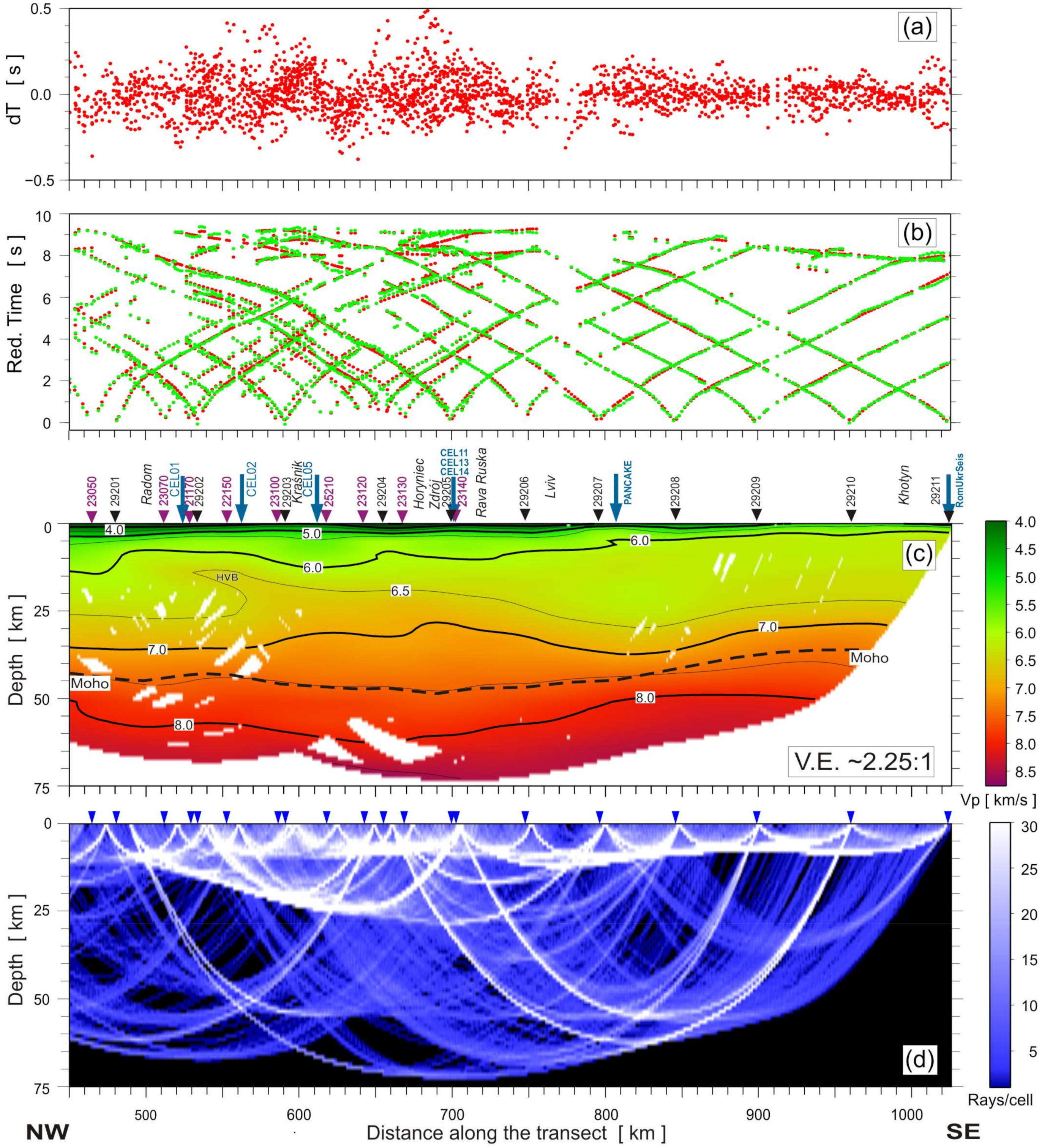


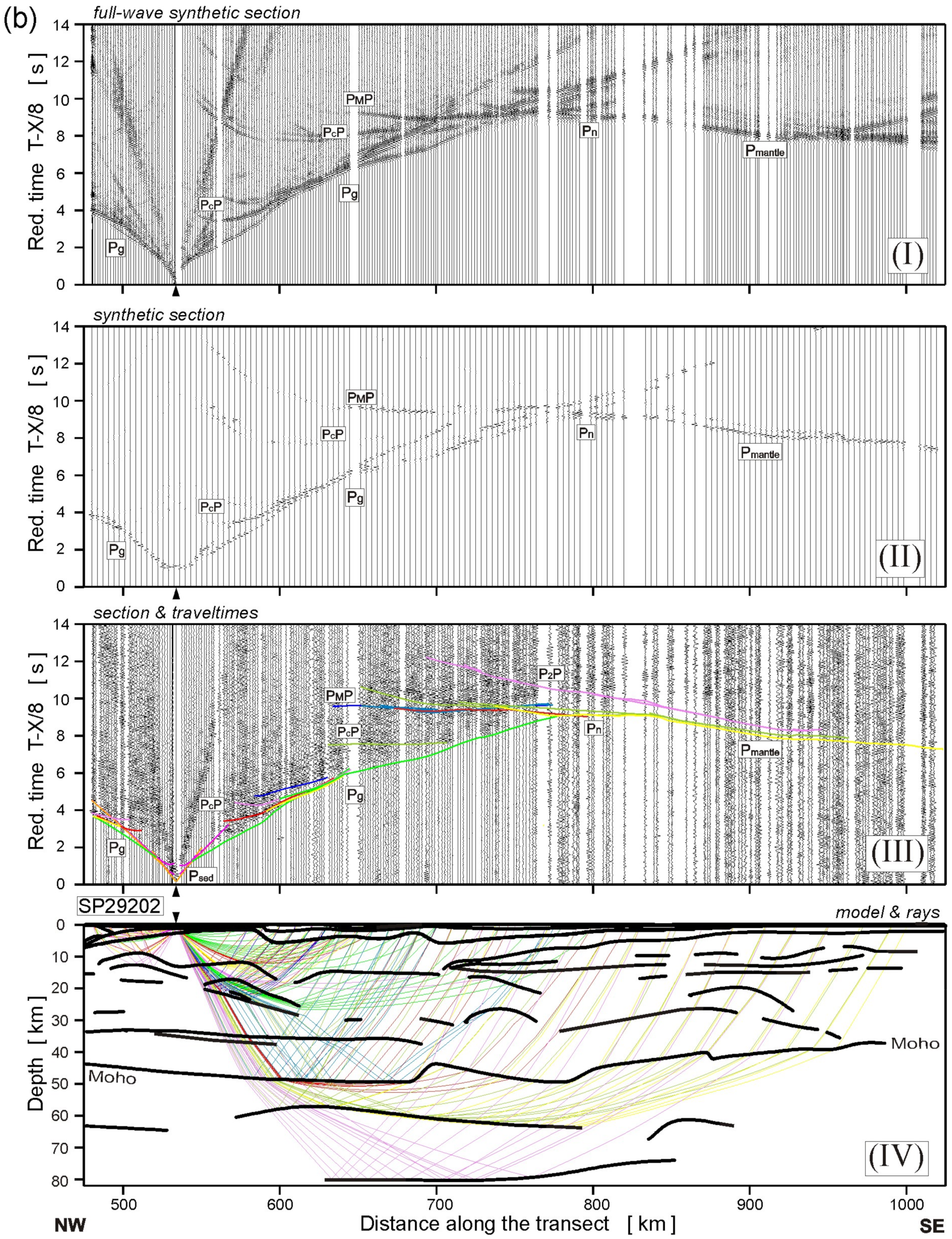
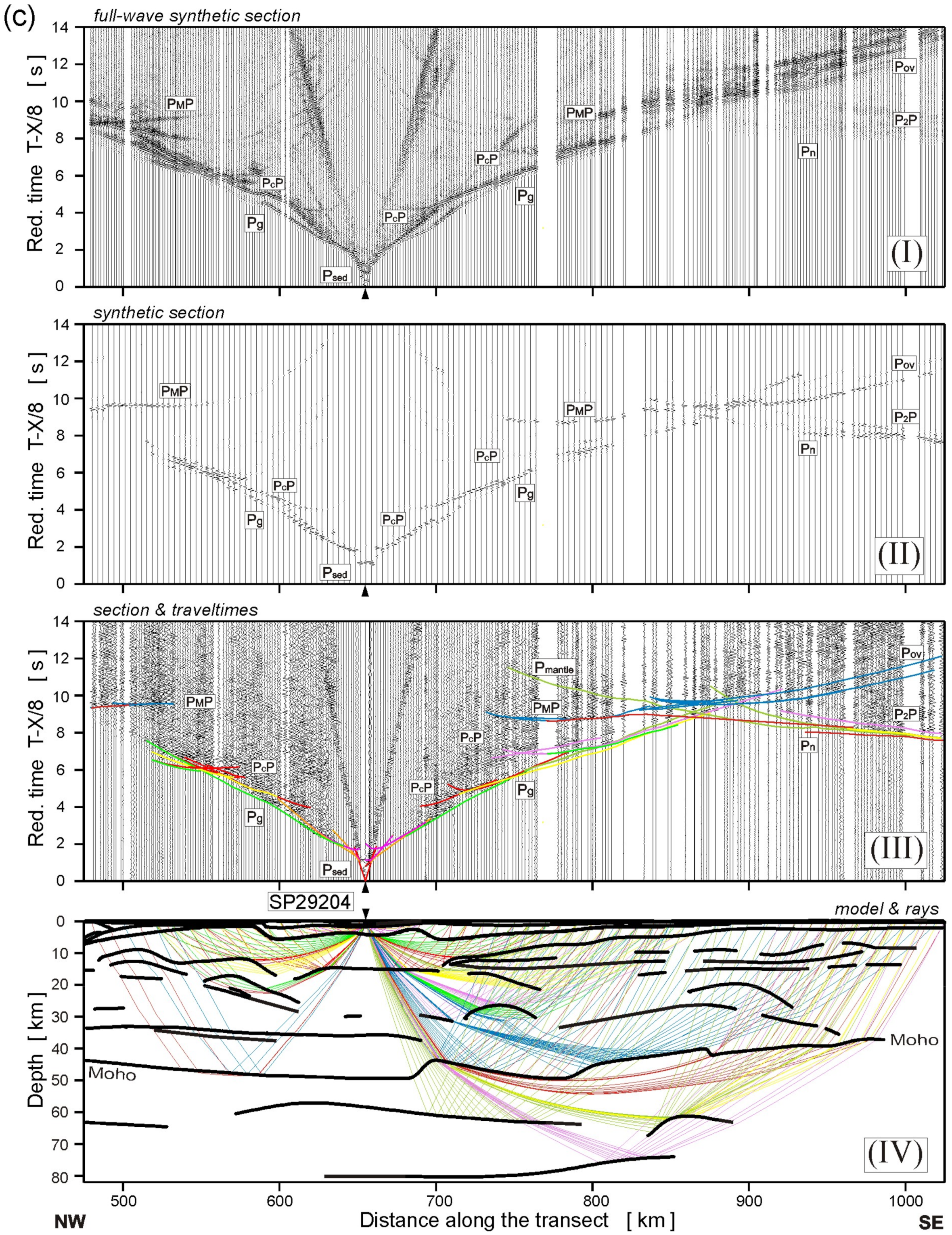


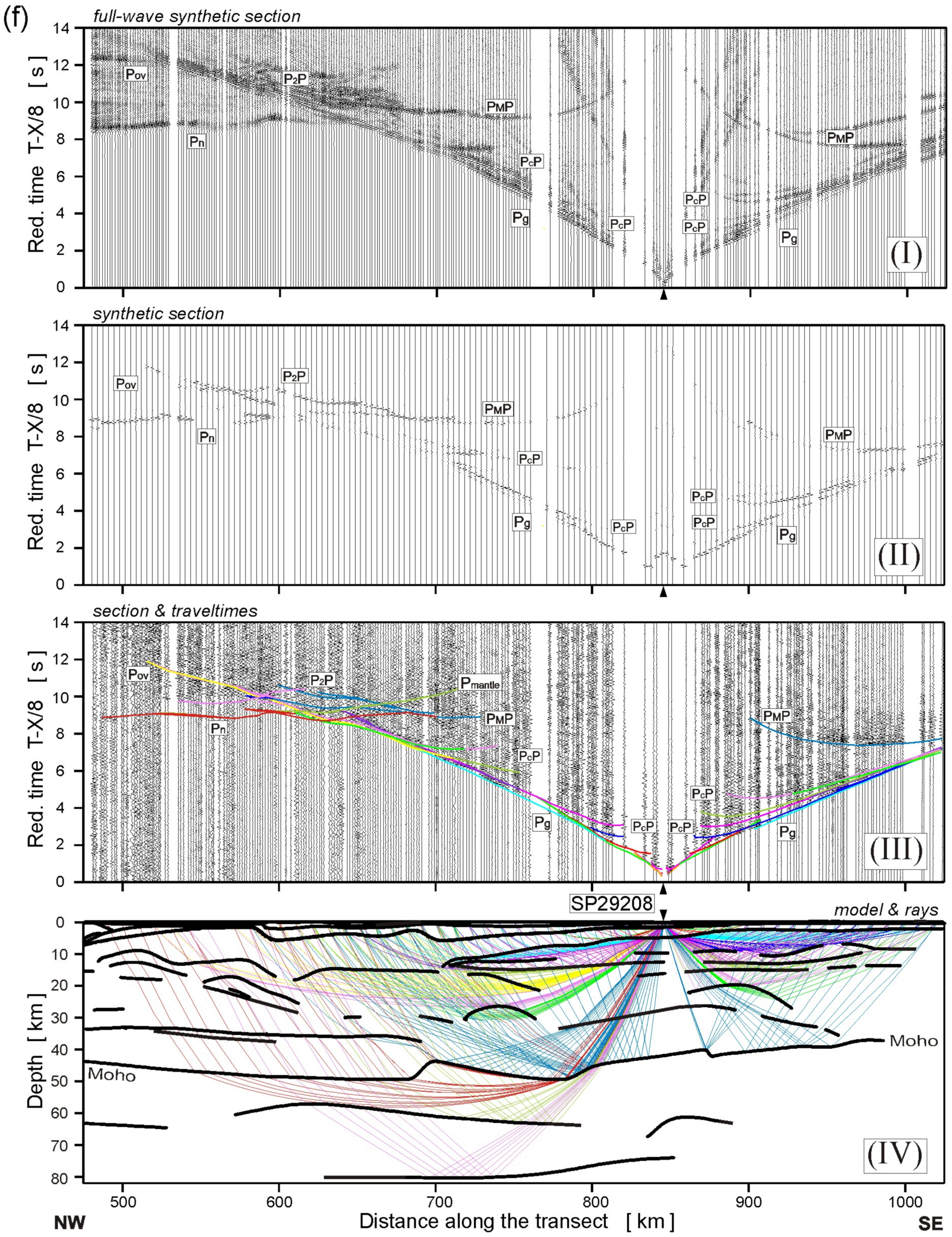
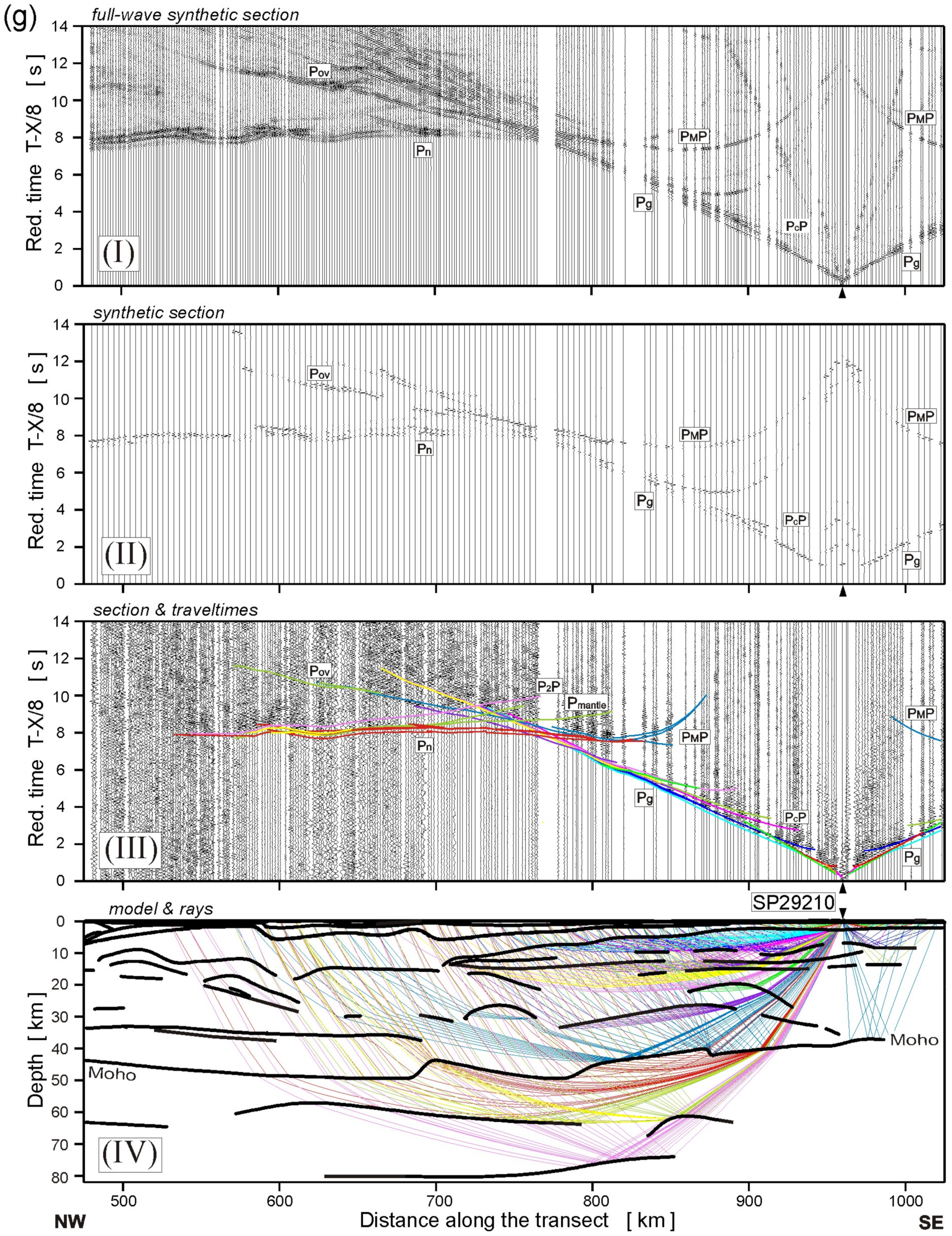
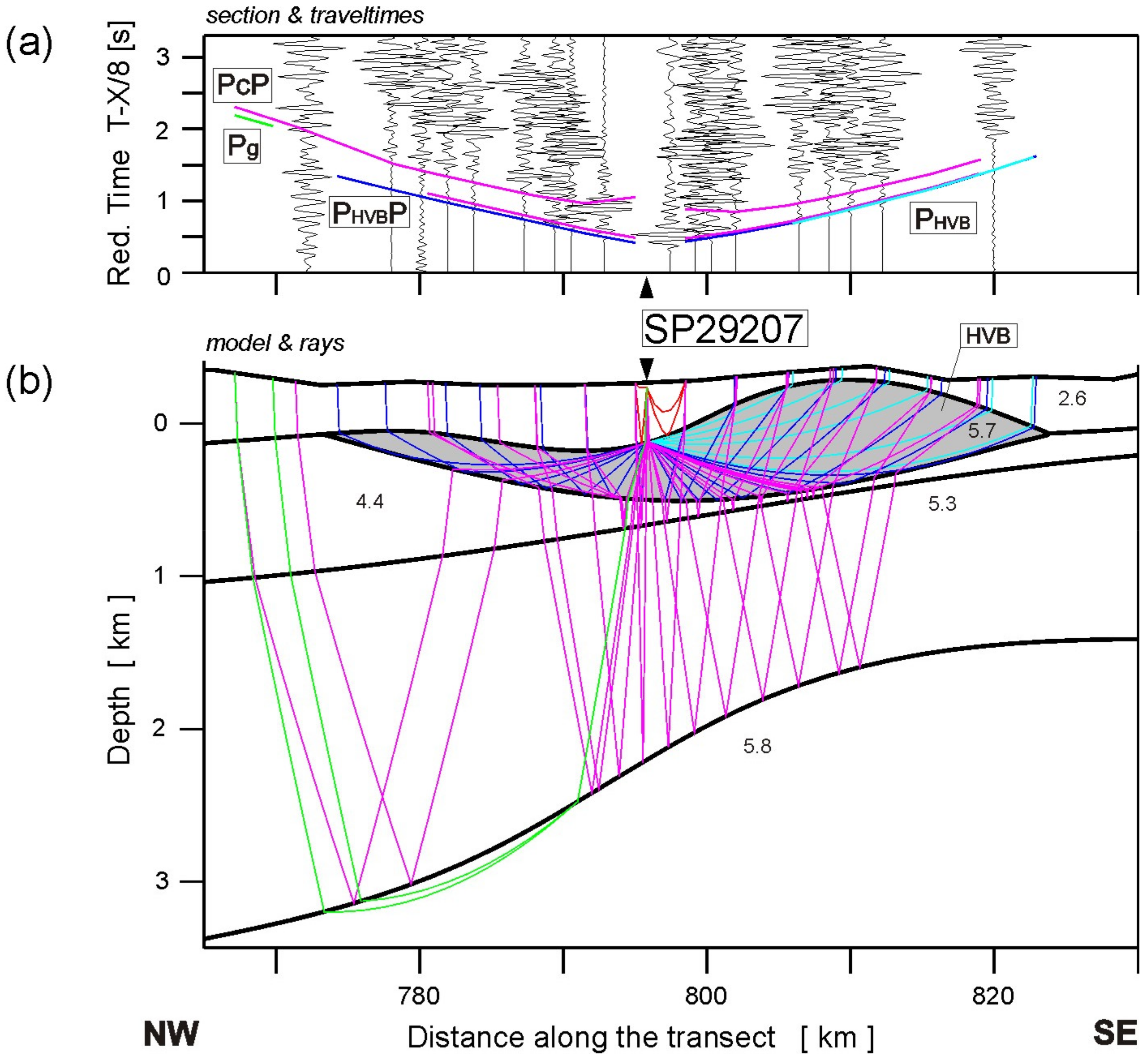
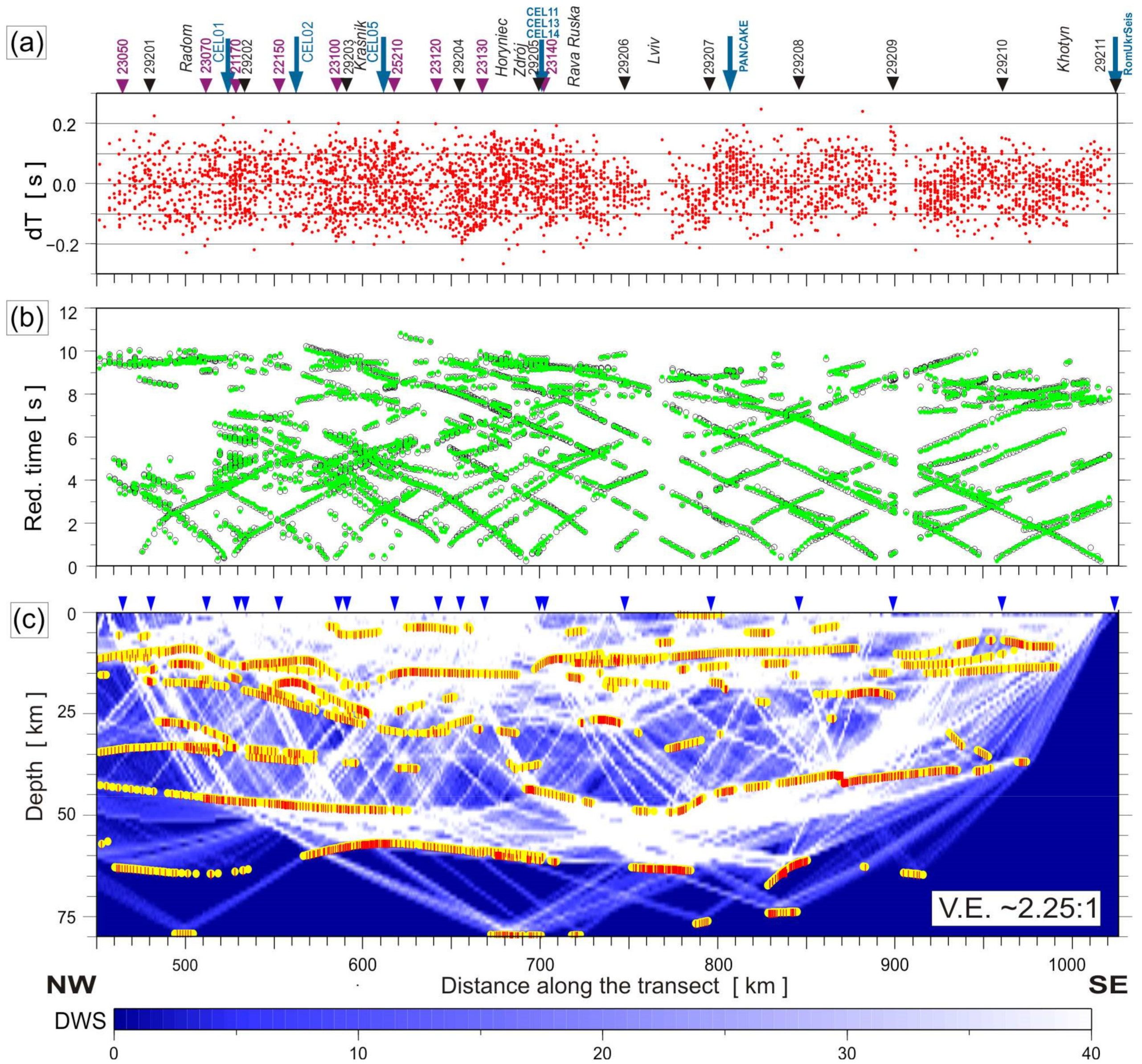
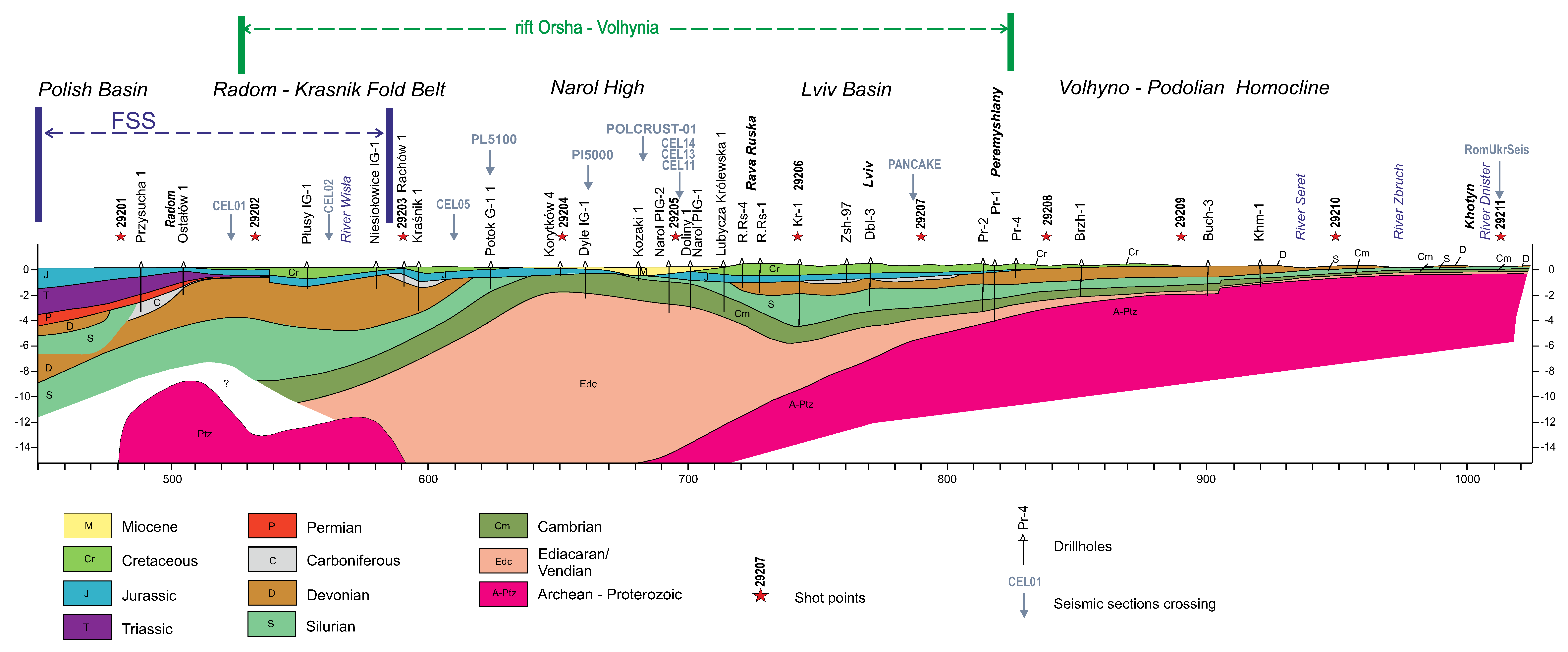
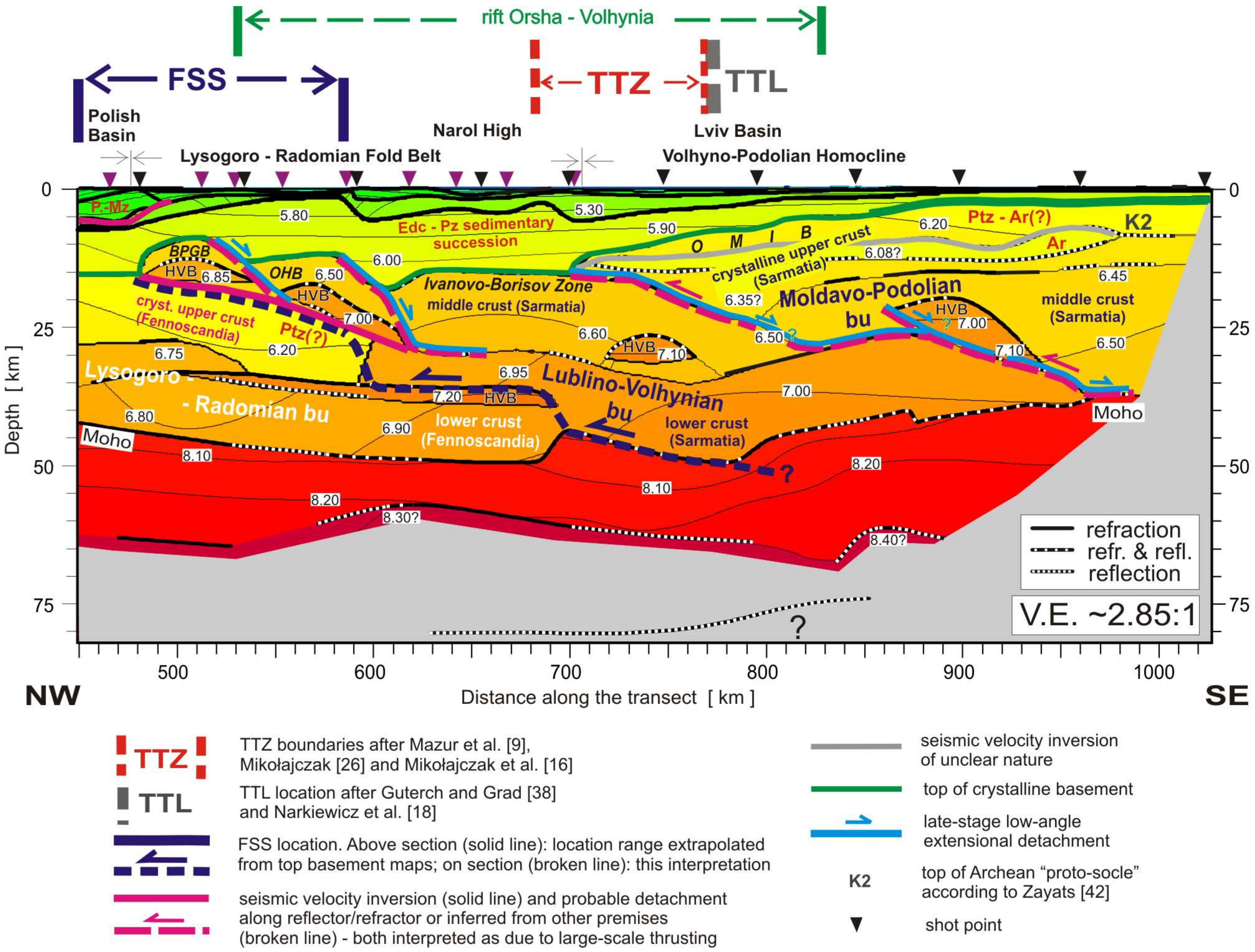
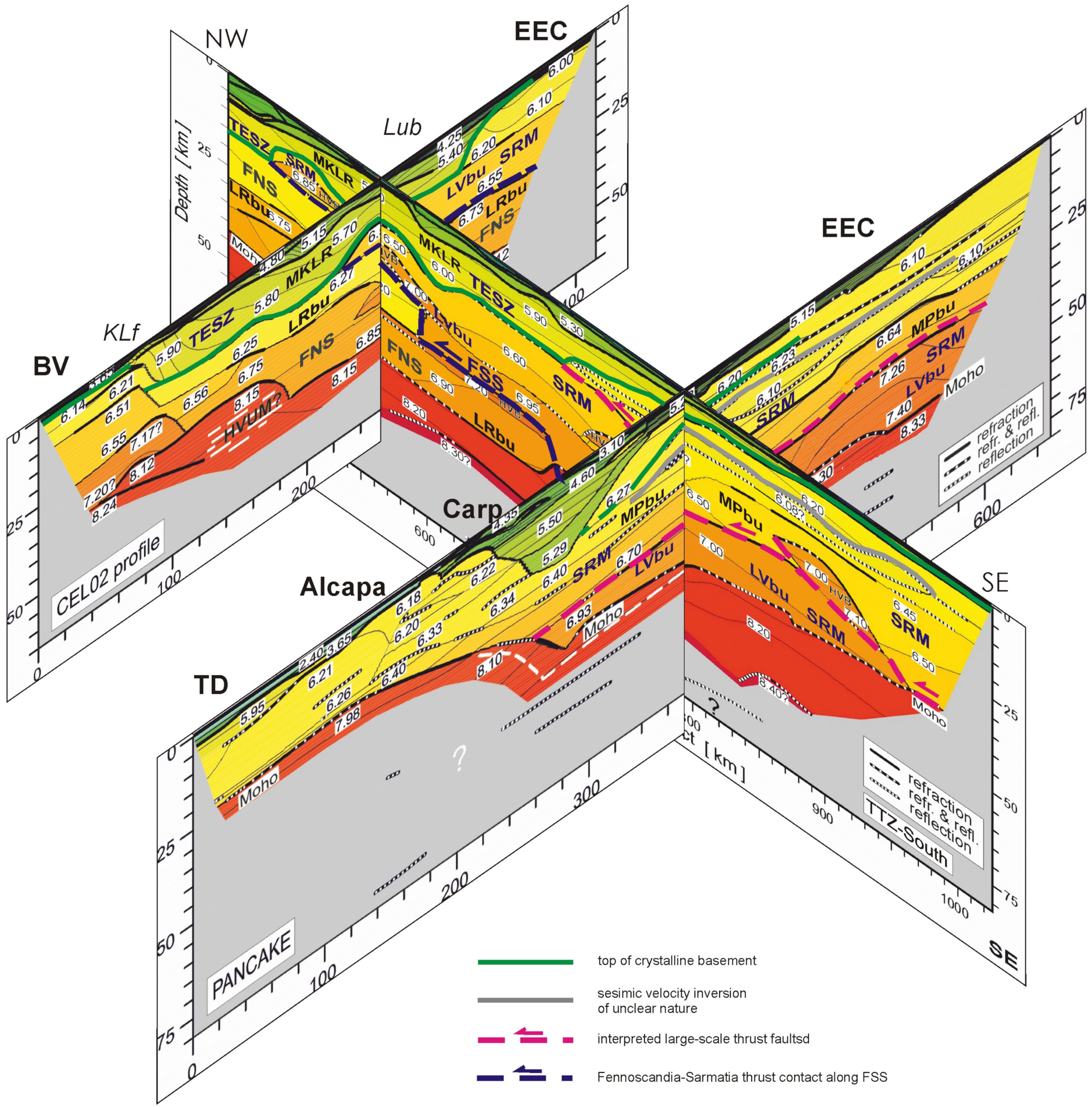

| Shot Point Number | Offset (km) | Distance (km) | Latitude N φ (deg) | Longitude E λ (deg) | Altitude h (m) | Time UTC (y:d:h:m:s) | Charge TNT (kg) | Borehole Depth (m) | Number of Boreholes |
|---|---|---|---|---|---|---|---|---|---|
| SP29201 | 0.0 | 480.674 | 51.42682 | 20.76500 | 180 | 2018:253:21:31:54.35 | 1000 | 30 | 20 |
| SP29202 | 53.086 | 533.759 | 51.16452 | 21.40077 | 208 | 2018:253:22:28:22.50 | 800 | 30 | 16 |
| SP29203 | 110.269 | 590.943 | 50.85157 | 22.04810 | 229 | 2018:255:22:27:55.07 | 700 | 30 | 14 |
| SP29204 | 174.186 | 654.860 | 50.48555 | 22.74625 | 199 | 2018:254:22:31:10.79 | 600 | 30 | 12 |
| SP29205 | 218.508 | 699.182 | 50.26772 | 23.27013 | 266 | 2018:255:23:01:08.45 | 600 | 30 | 12 |
| SP29206 | 266.532 | 747.205 | 49.99233 | 23.78797 | 338 | 2018:253:21:00:35.55 | 400 | 30 | 8 |
| SP29207 | 315.134 | 795.808 | 49.73712 | 24.33733 | 263 | 2018:254:21:00:17.89 | 500 | 30 | 10 |
| SP29208 | 364.615 | 845.288 | 49.45562 | 24.86747 | 349 | 2018:253:21:59:55.58 | 500 | 30 | 10 |
| SP29209 | 417.522 | 898.196 | 49.15783 | 25.43483 | 300 | 2018:254:21:59:51.67 | 500 | 30 | 10 |
| SP29210 | 478.827 | 959.501 | 48.78647 | 26.05512 | 251 | 2018:253:23:00:34.37 | 600 | 30 | 12 |
| SP29211 | 542.448 | 1023.121 | 48.43600 | 26.73787 | 172 | 2018:253:23:29:59.71 | 700 | 30 | 14 |
Publisher’s Note: MDPI stays neutral with regard to jurisdictional claims in published maps and institutional affiliations. |
© 2022 by the authors. Licensee MDPI, Basel, Switzerland. This article is an open access article distributed under the terms and conditions of the Creative Commons Attribution (CC BY) license (https://creativecommons.org/licenses/by/4.0/).
Share and Cite
Janik, T.; Starostenko, V.; Aleksandrowski, P.; Yegorova, T.; Czuba, W.; Środa, P.; Murovskaya, A.; Zayats, K.; Mechie, J.; Kolomiyets, K.; et al. Lithospheric Structure of the East European Craton at the Transition from Sarmatia to Fennoscandia Interpreted from the TTZ-South Seismic Profile (SE Poland to Ukraine). Minerals 2022, 12, 112. https://doi.org/10.3390/min12020112
Janik T, Starostenko V, Aleksandrowski P, Yegorova T, Czuba W, Środa P, Murovskaya A, Zayats K, Mechie J, Kolomiyets K, et al. Lithospheric Structure of the East European Craton at the Transition from Sarmatia to Fennoscandia Interpreted from the TTZ-South Seismic Profile (SE Poland to Ukraine). Minerals. 2022; 12(2):112. https://doi.org/10.3390/min12020112
Chicago/Turabian StyleJanik, Tomasz, Vitaly Starostenko, Paweł Aleksandrowski, Tamara Yegorova, Wojciech Czuba, Piotr Środa, Anna Murovskaya, Khrystyna Zayats, James Mechie, Katerina Kolomiyets, and et al. 2022. "Lithospheric Structure of the East European Craton at the Transition from Sarmatia to Fennoscandia Interpreted from the TTZ-South Seismic Profile (SE Poland to Ukraine)" Minerals 12, no. 2: 112. https://doi.org/10.3390/min12020112
APA StyleJanik, T., Starostenko, V., Aleksandrowski, P., Yegorova, T., Czuba, W., Środa, P., Murovskaya, A., Zayats, K., Mechie, J., Kolomiyets, K., Lysynchuk, D., Wójcik, D., Omelchenko, V., Legostaieva, O., Głuszyński, A., Tolkunov, A., Amashukeli, T., Gryn’, D., & Chulkov, S. (2022). Lithospheric Structure of the East European Craton at the Transition from Sarmatia to Fennoscandia Interpreted from the TTZ-South Seismic Profile (SE Poland to Ukraine). Minerals, 12(2), 112. https://doi.org/10.3390/min12020112






